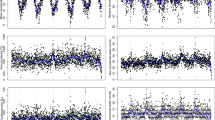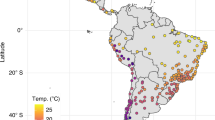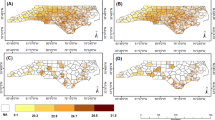Abstract
Background
Ambient temperatures exceeding 40 °C are projected to become common in many temperate climatic zones due to global warming. Therefore, understanding the health effects of continuous exposure to high ambient temperatures on populations living in hot climatic regions can help identify the limits of human tolerance.
Objective
We studied the relationship between ambient temperature and non-accidental mortality in the hot desert city of Mecca, Saudi Arabia, between 2006 and 2015.
Methods
We used a distributed lag nonlinear model to estimate the mortality-temperature association over 25 days of lag. We determined the minimum mortality temperature (MMT) and the deaths that are attributable to heat and cold.
Results
We analyzed 37,178 non-accidental deaths reported in the ten-year study period among Mecca residents. The median average daily temperature was 32 °C (19–42 °C) during the same study period. We observed a U-shaped relationship between daily temperature and mortality with an MMT of 31.8 °C. The total temperature-attributable mortality of Mecca residents was 6.9% (−3.2; 14.8) without reaching statistical significance. However, extreme heat, higher than 38 °C, was significantly associated with increased risk of mortality. The lag structure effect of the temperature showed an immediate impact, followed by a decline in mortality over many days of heat. No effect of cold on mortality was observed.
Impact statement
High ambient temperatures are projected to become future norms in temperate climates. Studying populations familiar with desert climates for generations with access to air-conditioning would inform on the mitigation measures to protect other populations from heat and on the limits of human tolerance to extreme temperatures. We studied the relationship between ambient temperature and all-cause mortality in the hot desert city of Mecca. We found that Mecca population is adapted to high temperatures, although there was a limit to tolerance to extreme heat. This implies that mitigation measures should be directed to accelerate individual adaptation to heat and societal reorganization.
This is a preview of subscription content, access via your institution
Access options
Subscribe to this journal
Receive 6 print issues and online access
$259.00 per year
only $43.17 per issue
Buy this article
- Purchase on Springer Link
- Instant access to full article PDF
Prices may be subject to local taxes which are calculated during checkout




Similar content being viewed by others
Data availability
Anonymized data will be available from the corresponding author (SY) on a reasonable request and on an appropriate data sharing agreement, subject to review and after approval of a study proposal by the Saudi Ministry of Health General Department of Research and Studies (GDRS-IRB@moh.gov.sa).
References
Mora C, Dousset B, Caldwell IR, Powell FE, Geronimo RC, Bielecki Coral R, et al. Global risk of deadly heat. Nat Clim Change. 2017;7:501–6.
Vicedo-Cabrera AM, Scovronick N, Sera F, Roye D, Schneider R, Tobias A, et al. The burden of heat-related mortality attributable to recent human-induced climate change. Nat Clim Chang. 2021;11:492–500.
Witze A. Extreme heatwaves: surprising lessons from the record warmth. Nature. 2022;608:464–5.
Christidis N, McCarthy M, Stott PA. The increasing likelihood of temperatures above 30 to 40 degrees C in the United Kingdom. Nat Commun. 2020;11:3093.
Pal JS, Eltahir EAB. Future temperature in southwest Asia projected to exceed a threshold for human adaptability. Nat Clim Change. 2016;6:197–200.
World Health Organization. Heat–health action plans: guidance. Copenhagen, Denmark: WHO; 2008.
Turek-Hankins LL, Coughlan de Perez E, Scarpa G, Ruiz-Diaz R, Schwerdtle PN, Joe ET, et al. Climate change adaptation to extreme heat: a global systematic review of implemented action. Oxford Open Climate Change. 2021;1kgab005.
Gasparrini A, Guo Y, Hashizume M, Lavigne E, Zanobetti A, Schwartz J, et al. Mortality risk attributable to high and low ambient temperature: a multicountry observational study. Lancet. 2015;386:369–75.
Yin Q, Wang J, Ren Z, Li J, Guo Y. Mapping the increased minimum mortality temperatures in the context of global climate change. Nat Commun. 2019;10:4640.
Tobias A, Hashizume M, Honda Y, Sera F, Ng CFS, Kim Y, et al. Geographical variations of the minimum mortality temperature at a global scale: a multicountry study. Environ Epidemiol. 2021;5:e169.
Fischer EM, Sippel S, Knutti R. Increasing probability of record-shattering climate extremes. Nat Clim Change. 2021;11:689–95.
Abdou AEA. Temperature trend on Makkah, Saudi Arabia. Atmos Clim Sci. 2014;4:457–81.
Yezli S. Risk factors for heat-related illnesses during the Hajj mass gathering: an expert review. Rev Environ Health. 2021;38:33–43.
Gasparrini A, Leone M. Attributable risk from distributed lag models. BMC Med Res Methodol. 2014;14:55.
Armstrong B. Models for the relationship between ambient temperature and daily mortality. Epidemiology. 2006;17:624–31.
Guo Y, Gasparrini A, Armstrong B, Li S, Tawatsupa B, Tobias A, et al. Global variation in the effects of ambient temperature on mortality: a systematic evaluation. Epidemiology. 2014;25:781–9.
Gasparrini A, Armstrong B, Kenward MG. Distributed lag non-linear models. Stat Med. 2010;29:2224–34.
Alahmad B, Shakarchi AF, Khraishah H, Alseaidan M, Gasana J, Al-Hemoud A, et al. Extreme temperatures and mortality in Kuwait: Who is vulnerable? Sci Total Environ. 2020;732:139289.
Braga AL, Zanobetti A, Schwartz J. The time course of weather-related deaths. Epidemiology. 2001;12:662–7.
Rodrigues M, Santana P, Rocha A. Bootstrap approach to validate the performance of models for predicting mortality risk temperature in Portuguese Metropolitan Areas. Environ Health. 2019;18:25.
Ruuhela R, Votsis A, Kukkonen J, Jylhä K, Kankaanpää S, Perrels A. Temperature-related mortality in Helsinki compared to its surrounding region over two decades, with special emphasis on intensive heatwaves. Atmosphere. 2021;12:46.
Ha J, Shin Y, Kim H. Distributed lag effects in the relationship between temperature and mortality in three major cities in South Korea. Sci Total Environ. 2011;409:3274–80.
Hajat S, Armstrong BG, Gouveia N, Wilkinson P. Mortality displacement of heat-related deaths: a comparison of Delhi, Sao Paulo, and London. Epidemiology. 2005;16:613–20.
Mercereau L, Todd N, Rey G, Valleron AJ. Comparison of the temperature-mortality relationship in foreign born and native born died in France between 2000 and 2009. Int J Biometeorol. 2017;61:1873–84.
Bouchama A, Abuyassin B, Lehe C, Laitano O, Jay O, O’Connor FG, et al. Classic and exertional heatstroke. Nat Rev Dis Prim. 2022;8:8.
Periard JD, Racinais S, Sawka MN. Adaptations and mechanisms of human heat acclimation: applications for competitive athletes and sports. Scand J Med Sci Sports. 2015;25:20–38.
Horowitz M. Epigenetics and cytoprotection with heat acclimation. J Appl Physiol. 2016;120:702–10.
Skinner MK. Environmental stress and epigenetic transgenerational inheritance. BMC Med. 2014;12:153.
Lindholm ME, Marabita F, Gomez-Cabrero D, Rundqvist H, Ekstrom TJ, Tegner J, et al. An integrative analysis reveals coordinated reprogramming of the epigenome and the transcriptome in human skeletal muscle after training. Epigenetics. 2014;9:1557–69.
Zeng J, Zhang X, Yang J, Bao J, Xiang H, Dear K, et al. Humidity may modify the relationship between temperature and cardiovascular mortality in Zhejiang Province, China. Int J Environ Res Public Health. 2017;14:1383.
O’Neill MS, Zanobetti A, Schwartz J. Modifiers of the temperature and mortality association in seven US cities. Am J Epidemiol. 2003;157:1074–82.
Son JY, Liu JC, Bell ML. Temperature-related mortality: a systematic review and investigation of effect modifiers. Environ Res Lett 2019;13:073004.
Cheng J, Xu Z, Bambrick H, Su H, Tong S, Hu W. Impacts of exposure to ambient temperature on burden of disease: a systematic review of epidemiological evidence. Int J Biometeorol 2019;63:1099–115.
Author information
Authors and Affiliations
Contributions
SY, AB, BMA, and AHK conceptualized the study and its design. SY, AB, and AHK participated in the literature search. SY and BMA were involved in data acquisition. SY, YMY, and AHK participated in data collection. SY and AHK participated in the data analysis. SY, AHK, and YMY participated in the visualization. All authors participated in the interpretation of the study results. SY, AB, and AHK participated in the writing of the first draft of the manuscript. All authors participated in reviewing and editing the original manuscript and reviewed and approved the final manuscript. SY, AB, and AHK verified the underlying data. All authors had full access to all the data in the study and had the final responsibility for the decision to submit for publication.
Corresponding authors
Ethics declarations
Competing interests
The authors declare no competing interests.
Ethics approval and consent to participate
The study was approved by the Ethics Committee of King Fahad Medical City and the Institutional Review Board (IRB log #:17-141E) and was carried out according to the Ethics Committee guidelines. Consent was waived, as this is an observational study that retrospectively analyzed aggregate deidentified mortality data.
Additional information
Publisher’s note Springer Nature remains neutral with regard to jurisdictional claims in published maps and institutional affiliations.
Supplementary information
Rights and permissions
Springer Nature or its licensor (e.g. a society or other partner) holds exclusive rights to this article under a publishing agreement with the author(s) or other rightsholder(s); author self-archiving of the accepted manuscript version of this article is solely governed by the terms of such publishing agreement and applicable law.
About this article
Cite this article
Yezli, S., Khan, A.H., Yassin, Y.M. et al. Human tolerance to extreme heat: evidence from a desert climate population. J Expo Sci Environ Epidemiol 33, 631–636 (2023). https://doi.org/10.1038/s41370-023-00549-7
Received:
Revised:
Accepted:
Published:
Issue Date:
DOI: https://doi.org/10.1038/s41370-023-00549-7



